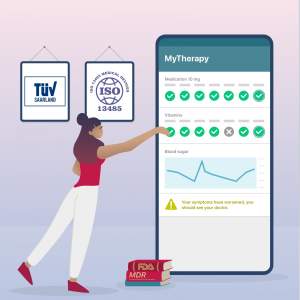DTx at eyeforpharma 2020: Successful Pilots, but a Need for New Partnership Models
Despite Teething Problems, Standalone Digital Therapeutics (DTx) will Join ‘Around the Pill’ Solutions as Part of Pharma’s Future

- As pilot projects are wrapping up, innovation leaders like Novartis and Sanofi see evidence-based digital therapeutics increasingly moving to the core business
- ‘Around the Pill’ & ‘Prescription DTx’ are not an either/or decision for pharma, but the underlying business case and perceived barriers differ
- Learnings from first-generation DTx point towards a need for partnerships that avoid conflicts of interests in particular as products prove successful
This year’s eyeforpharma spring summits have gone digital in response to the coronavirus outbreak. The speed with which the organizers were able to rearrange the events to become a ‘virtual’ summits is a testament to the technological capabilities we have at our fingertips these days, a point that was reinforced by the number of hours devoted to digital health in general and digital therapeutics in particular.
Key talking points included the role partnerships play in the development of digital therapeutics and the differentiation of ‘around the pill’ solutions and standalone prescribable DTx products. So, what exactly did we learn from some of the notable speakers at the events?
‘Around the Pill’ & Standalone DTx Have a Place in Pharma’s Portfolio
Although there is still plenty of debate regarding the exact definition of what constitutes a digital therapeutic, there was a general consensus among the speakers at eyeforpharma that digital solutions can largely be divided into two categories. The first, ‘around the pill’ or ‘beyond the pill’ solutions, are designed to improve the efficacy of a traditional therapeutic. The second, ‘standalone’ or ‘prescribable’ digital therapeutics act as a far more independent treatment option (although they can, of course, be prescribed as part of combination therapy with a traditional drug).
What was evident at eyeforpharma is that, despite teething problems ranging from regulatory issues to unsuccessful partnerships, pharma’s major players still see the long-term potential of both buckets of DTx.
The Case for ‘Around the Pill’ Digital Therapeutics
The arguments for ‘around the pill’ digital therapeutics are pretty well established, both in terms of the benefits they offer patients and the value they add to new and existing drugs. They are the obvious entry point to digital therapeutics for pharma.
In his speech at eyeforpharma, Jeremy Sohn, VP, Head of Digital Business Development & Licensing at Novartis, reeled off several examples of the different disease areas ‘around the pill’ solutions are benefiting patients, putting particular focus on solutions for people living with cancer: “Oncology patients struggle, not just with the treatment for the disease but also with staying on top of their nutrition, eating the right meals and the right foods, and avoiding certain others. Nutrition, as well as mindfulness and sleep, are key to the totality of treatment for, really any kind of patient, but that’s even more true for oncology patients.”
Anish Shindore, Head of Digital Acceleration - DTx at Sanofi, provided a few more details about how ‘around the pill’ DTx products can be financially beneficial to pharma: “What we are looking to do is boost the sales of our products by introducing a much more comprehensive offering with the digital therapeutic solution. With that, what we really intend on doing is we try to make sure that we have more ‘switch-ins’ to our product.”
Anish Shindore also focused on the vast quantities of data that can be collected from digital therapeutics, which will help sway doctors towards the products and add value to the product.
“When you have such a comprehensive offering, there is a tendency for doctors to look at data and have fact-based discussions with their patients so that’s one of the things that we look at. If we are able to prove that with a combination therapy that there is a new indication and comprehensive therapy with data that gives more access to information, then, of course, there is a discussion that we want to look at that bundle pricing.”

The enthusiasm of Jeremy Sohn and Anish Shindore for ‘around the pill’ DTx solutions was echoed by other pharma companies and technology firms throughout the week. The benefits of increasing a traditional drug’s efficacy with a digital counterpart are now plain for everyone to see and the rapidly evolving industry is already benefiting pharma, tech, healthcare professionals, and – most importantly – patients.
But what about standalone DTx?
Does Pharma Have a Role in Standalone DTx?
Although the enthusiasm for ‘around the pill’ DTx solutions was palpable at eyeforpharma, the tone taken towards standalone DTx was rather more cautious. Barriers to entry, such as regulatory requirements and the need for clinical trials, make standalone digital therapeutics a far more costly and time-consuming proposition. With reimbursement models for digital therapeutics still in their infancy, the risks relating to return-on-investment are more significant.
What’s more, several high-profile break-ups or “partnership restructures”, including Novartis/Sandoz and Pear Therapeutics (developers of reSET and reSET-O), and Sanofi and Onduo, have cast doubt over the long-term potential for standalone DTx products to form a part of pharma’s portfolio.
However, when we look at these deals, it is clear that the long-term strategic goals of the companies involved in each partnership diverged somewhere along the line. Regarding the Sanofi and Onduo relationship, for example, it appears as though the deal fell victim to a much broader move from Sanofi away from the diabetes therapeutic area. A similar refocusing of efforts within Sandoz was cited as a reason for the split with Pear Therapeutics, along with Pear’s increased capability to handle commercialization independently.
These kinds of issues are naturally more likely to happen in partnerships relating to standalone digital therapeutics, given that the product is not so intrinsically linked to a traditional drug. Issues such as a clash of cultures (the fast-moving world of tech versus the slower pharma industry) and pharma’s desire for a faster return on investment may also contribute to a deterioration in relationships.
However, none of these signals the death of pharma’s involvement in standalone DTx.
On the contrary, these break-ups – which have been remarkably amicable – highlight the difficulty in combining two very different worlds. Difficult, though, is not impossible. At eyeforpharma, Jeremy Sohn made clear that Novartis has not been alienated by the experiences with Pear Therapeutics and even spoke of reSET and reSET-O multiple times in his presentation and the following Q&A session. Speaking of Novartis’ stance of potential DTx partnerships, he said:
“When the drug is a prescription digital therapeutic, it’s clear that these are drugs, that these are interventions that have gone through the same rigorous clinical trials and regulatory process, and they’ve got a clear benefit and a disease-modifying advantage for patients.”
“As long as it’s disease-modifying and meets the evidence criteria, we’re all in.”
– Jeremy Sohn, VP, Head of Digital Business Development & Licensing, Novartis
He alluded to products that will be spoken of publicly in the near future, which will surely stand a better chance of sustained success courtesy of the lessons learned.
While the enthusiasm is still evident, only time will tell how these partnerships will pan out. The question we will gradually be able to answer in the coming months is: are pharma and tech finding solutions to the tough challenges faced in structuring partnerships?
Necessity Breeds Innovation, Even in How Partnerships are Formed
Both ‘around the pill’ and standalone digital therapeutics are part of pharma’s future. Although the former is more developed and arguably more straightforward, innovative and mutually beneficial partnership models will see standalone DTx solutions follow suit.
At eyeforpharma, there were plenty of examples that helped demonstrate how partnerships with pharma are helping DTx developers advance their products and deal with complex issues – such as clinical trials – with which pharma are familiar. To scale up, partnership models need to evolve and become complementary at every stage of a DTx’s product lifecycle.
Over the past months and years, we’ve been working closely with pharma and continuously adapted our platform and approach to the increasing need for complementary capabilities without sacrificing ownership of critical control points. An increasing number of pharma companies realize that there is a lot to gain for them in the DTx space, but they need to focus on their core assets and capabilities. These companies need a partner for product development and global DTx operations who is up to the regulatory requirements coming with medical devices. If these topics matter to you, don’t hesitate to reach out.



